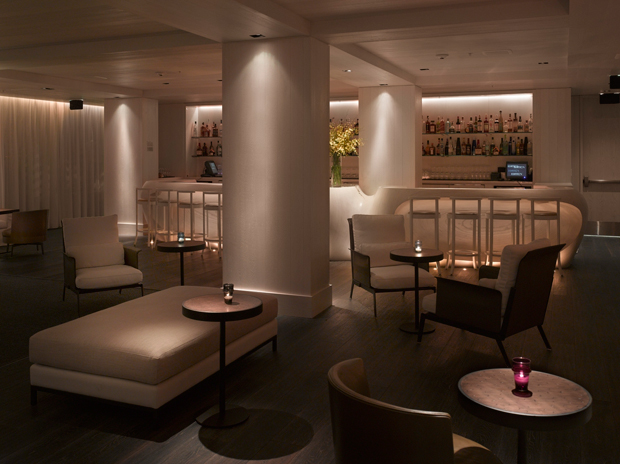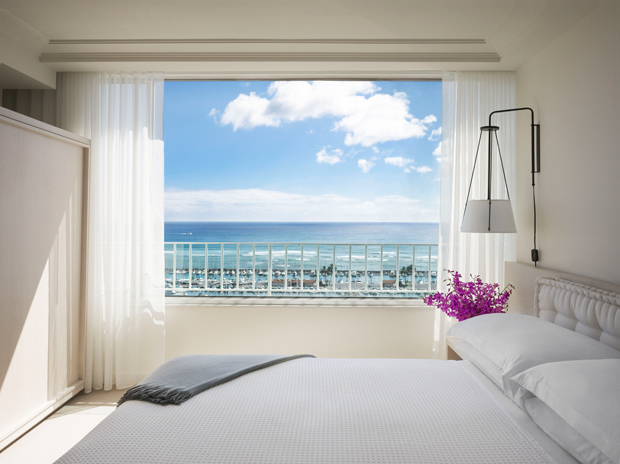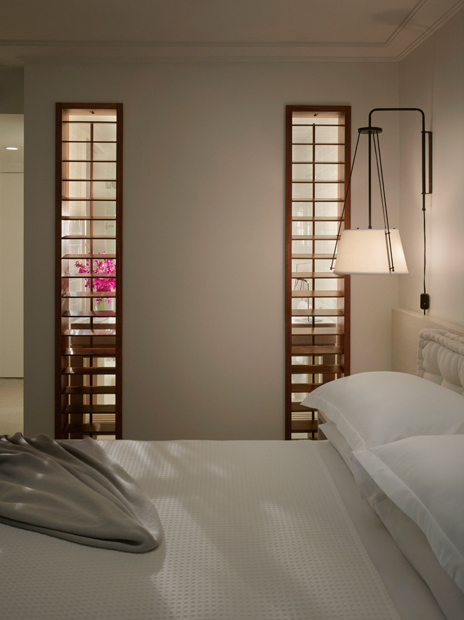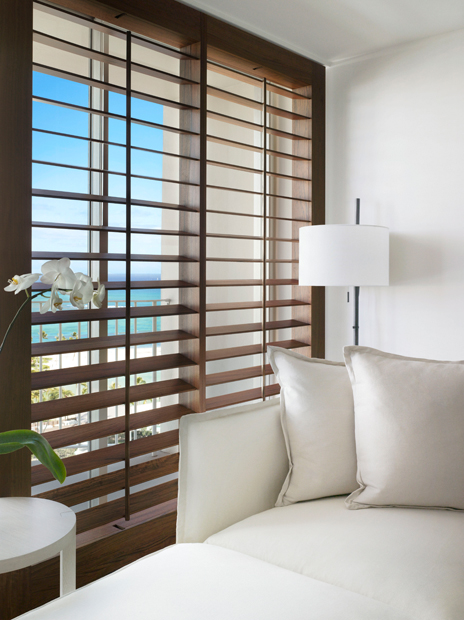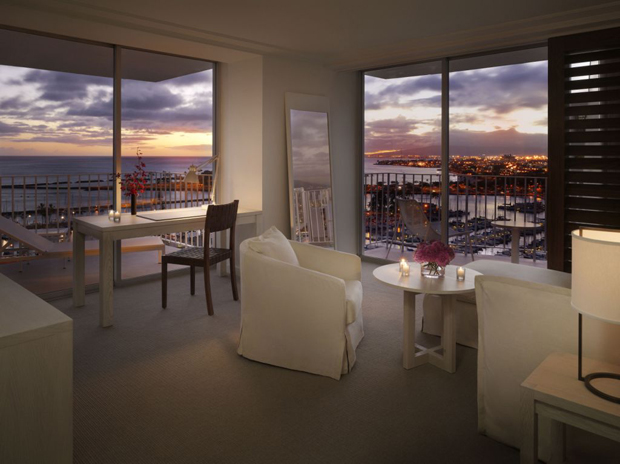Ian Schrager’s decision to join forces with Bill Marriott, teetotal septuagenarian heir to a global empire of three thousand reliably high-class but thoroughly conventional hotels, was greeted with raised eyebrows within in the industry. This was another unexpected turn in an extraordinary thirty five year career, but for both Schrager and his new partner, the deal is one that takes them into exciting new territory. For Marriott, their new Edition brand represents his move into the burgeoning boutique hotel market, estimated to be the fastest growing sector of the multi-billion dollar global hotel industry, and for Schrager it is an opportunity to take his deserved market share of what he created twenty-five years ago. Schrager was first the the original enfant terrible of the New York club circuit when it was at its most hedonistic and mythologized height, and then the revolutionary who changed the face of the hotel industry forever with his mould-breaking boutique hotels, and now he is seen as the godfather of modern hospitality - having changed our perception of what a hotel is and can be.
The Edition brand plans to open an unprecedented 100 boutique, or lifestyle, hotels in major cities and tourist destinations around the world, each one funded by independent developers, designed by Schrager and his team, and managed by the Marriott group. Whilst each hotel will be specifically molded around its location, organically interpreting the themes and ambience of the setting, all will also bear the Schrager and Marriott hallmarks, a sense of having arrived at the cultural and social epicenter, coupled with the unrelentingly high standards of service and customer satisfaction that one expects from a Marriott Hotel. This month, The Waikiki Edition hotel complex was the prestigious first Edition hotel complex to open, with outposts of this innovative new brand set to open in Istanbul, Mexico and Miami to name just a few exclusive locations.
The boutique aesthetic tips everything on its head - it warps dimensions and bends things back on themselves. Small is at once also big, the biggest even, in the sense that exclusivity breeds an unattainable ubiquity - there are likely to be at least ten times as many people who say they went to Studio 54 in the late 1970s as actually did. As co-founder of this epitome of 1970s cool, Ian Schrager definitely was there. In its heyday his social boutique was the flame for the moths of celebrity, the most famous nightclub in the world, unique, unusual and ultra-exclusive. It was in that sense simultaneously the smallest of the small and the biggest of the big. He learned that a place becomes special when it is frequented by stars; a place becomes a legend when it is more famous, more lasting, more recognized, more imitated, more aloof, and more indefinable than the stars themselves.
This stubbornly idiosyncratic sensibility, of something being stylish for its own reasons, of deliberately fostering an almost coincidental relationship with fame and the famous, is one that Ian Schrager and his Studio 54 co-founder Steve Rubell took with them into their next business venture. Morgans, the paradigm-busting hotel they created in 1984 by transforming the Depression era Executive Hotel into one of Manhattan’s most luxurious and best kept secrets, was as revolutionary to the traditionally staid hotel industry as Studio 54 had been to nightlife. With groundbreaking interiors designed by Andrée Putman, the hotel was provocative and enticing, and rapidly gained favor with precisely the same set of illustrious patrons as had Studio 54. In fact, the iconic photograph of an elegantly composed Bianca Jagger surveying the glittering chaos of the Studio 54 dance floor from a pristine white horse may be the most eloquent cameo of Schrager’s style. Morgans was jarringly lavish and viscerally seductive; one felt as if one had been expressly invited onto the set of the particularly surreal magnum opus of a neglected genius of Italian Cinema. This sense of a hotel and its interior as a performance was carried into the pair’s subsequent New York hotels - the Royalton, the Paramount and the Hudson - whose breathtaking interiors were designed by Philippe Starck, a global icon who redefined furniture and interiors, accentuating their seductive power above and beyond their function.
Schrager’s genius was simply to import the sense of ultra-chic nightlife that he had cultivated in his bars and nightclubs to the extravagant confines of the hotel. Instead of leaving his set of beautiful people behind at Studio 54, he brought them with him. He knew that the unique style - a blend of high design, haute couture and mischievous extravagance - and starry guest list would by definition make the hotels’ restaurants, bars, and nightclubs the top of any list of places to see and be seen.
Schrager has continued to break rules and redefine boundaries with a string of incredibly successful and completely distinct hotels, from his native New York to Miami, San Francisco, Los Angeles and London. Until the sale of his parent company Morgans Hotel Group, he was estimated to be New York’s largest single private hotelier. Most recently he has widened his scope of activity with the opening the convention-defying Gramercy Park Hotel, created in collaboration with Julian Schnabel, and 40 Bond, a bespoke luxury apartment and condominium complex in Manhattan’s ultra-trendy Noho district. Designed by Pritzker Prize-winning architects Herzog & de Meuron, 40 Bond provides the extraordinarily sculpted sense of place and impeccably connected, discreet and yet attentive twenty-four hour service to be found in all Schrager Hotels, but in a permanent residential setting.
The Waikiki Edition opened to a buzzing media and expectant cognoscenti this month and promises to raise the bar in the already fiercely competitive lifestyle hotel market. Drawn in harmony with the casual luxury of the beach and its surf oriented surroundings, the hotel emphasizes the sense of fluidity that so defines its setting. Languid luxury awaits the visitor from the outset. The lobby has soft and simple natural forms dominating the design scheme, echoing the tranquil power of the surf breaking outside. An original installation by pro-surfer turned artist Herbie Fletcher, a mural featuring broken shards of the surfboards of his world famous friends and rivals, hangs above the plywood reception desk, itself a piece of smooth minimalistic, almost ergonomic design, hand-crafted and finished using traditional Hawaiian surf-board making techniques.
The long clean sight lines of the ground floor carry you to the Lobby Bar, a gorgeously realized social hub that showcases the superlative quality of the design that the New York firm of Yabu Pushelberg have achieved throughout the hotel. From here, the guests’ experience literally takes off as they encounter a polished raw concrete stairway that stretches up to the second floor of the complex and draws them into its beating heart.
Its two pools provide The Waikiki Edition with a dual focus point and a lively, but private axis around which the languid social affairs of the day may revolve. The luscious Sunrise Pool at the center of the hotel features loungers that appear to be drifting on the ocean itself, and whose chaises, day beds and decking are of an aged gray teak that positively implores guests to set down and relax. Lush local trees, Bougainvillea and Jasmine envelope the space in an orchard and lend the all day bar a sense of lulled tranquility, complemented by the option of viewing first run movies and art installations at the outdoor movie theater. A unique inland oasis made from sand imported from the surrounding islands, the Private Sunset Beach and Bar has a private lagoon surrounded by indigenous fauna and affords guests a delicious ocean panorama by day, and an intimate candlelit enclave in which they can mix and play as the sun goes down.
The sea builds an appetite, and the food on offer at Morimoto Waikiki at Edition, is no less sumptuous and innovative than one would expect, where Chef Masaharu Morimoto presents his acclaimed fusion of Japanese and Western cuisine. Locally caught seasonal fish dishes, such as the raw Tuna Pizza with anchovy aioli and jalapeño, and Morimoto Sashimi - a terrine of seared toro, smoked salmon, barbequed eel, tuna and hamachi served with five different sauces, nourish the soul and inspire the palette. Crazybox, the complex’s exclusive nightclub lit by over 40,000 reclaimed antique light bulbs arranged in a unique light sculpture, invites guests through rusted steel doors into what feels like a secret basement in which the sheer exhilaration of dancing is unavoidable.
The interiors of the hotel’s rooms and suites, again lavishly styled by Yabu Pushelberg, all boast spectacular views of the city, harbor and the ever-changing Pacific Ocean from their oversize windows, and many also offer expansive sun terraces. The open extravagance of the 1,500 square foot Penthouse on the seventeenth floor, featuring its own 1,400 square foot landscaped wraparound terrace, original artwork, and its own private amenities - including a library - takes the breath away.
The Waikiki Edition achieves the astonishing feat of delivering an expansive and complete hotel and leisure complex, which is at the same time styled around a refined clientele’s expectation for intimacy amidst cutting edge, genre-bending design. With the Edition series of lifestyle hotels, Bill Marriott and Ian Schrager have achieved what must have seemed impossible - a branded boutique experience.
- Ben Stewart
The Waikiki Edition
Address: 1775 Ala Moana Boulevard
Honolulu, 96815
Tel: 808 943 5800 Reserve Online
Website: www.editionhotels.com
The Edition brand plans to open an unprecedented 100 boutique, or lifestyle, hotels in major cities and tourist destinations around the world, each one funded by independent developers, designed by Schrager and his team, and managed by the Marriott group. Whilst each hotel will be specifically molded around its location, organically interpreting the themes and ambience of the setting, all will also bear the Schrager and Marriott hallmarks, a sense of having arrived at the cultural and social epicenter, coupled with the unrelentingly high standards of service and customer satisfaction that one expects from a Marriott Hotel. This month, The Waikiki Edition hotel complex was the prestigious first Edition hotel complex to open, with outposts of this innovative new brand set to open in Istanbul, Mexico and Miami to name just a few exclusive locations.
The boutique aesthetic tips everything on its head - it warps dimensions and bends things back on themselves. Small is at once also big, the biggest even, in the sense that exclusivity breeds an unattainable ubiquity - there are likely to be at least ten times as many people who say they went to Studio 54 in the late 1970s as actually did. As co-founder of this epitome of 1970s cool, Ian Schrager definitely was there. In its heyday his social boutique was the flame for the moths of celebrity, the most famous nightclub in the world, unique, unusual and ultra-exclusive. It was in that sense simultaneously the smallest of the small and the biggest of the big. He learned that a place becomes special when it is frequented by stars; a place becomes a legend when it is more famous, more lasting, more recognized, more imitated, more aloof, and more indefinable than the stars themselves.
This stubbornly idiosyncratic sensibility, of something being stylish for its own reasons, of deliberately fostering an almost coincidental relationship with fame and the famous, is one that Ian Schrager and his Studio 54 co-founder Steve Rubell took with them into their next business venture. Morgans, the paradigm-busting hotel they created in 1984 by transforming the Depression era Executive Hotel into one of Manhattan’s most luxurious and best kept secrets, was as revolutionary to the traditionally staid hotel industry as Studio 54 had been to nightlife. With groundbreaking interiors designed by Andrée Putman, the hotel was provocative and enticing, and rapidly gained favor with precisely the same set of illustrious patrons as had Studio 54. In fact, the iconic photograph of an elegantly composed Bianca Jagger surveying the glittering chaos of the Studio 54 dance floor from a pristine white horse may be the most eloquent cameo of Schrager’s style. Morgans was jarringly lavish and viscerally seductive; one felt as if one had been expressly invited onto the set of the particularly surreal magnum opus of a neglected genius of Italian Cinema. This sense of a hotel and its interior as a performance was carried into the pair’s subsequent New York hotels - the Royalton, the Paramount and the Hudson - whose breathtaking interiors were designed by Philippe Starck, a global icon who redefined furniture and interiors, accentuating their seductive power above and beyond their function.
Schrager’s genius was simply to import the sense of ultra-chic nightlife that he had cultivated in his bars and nightclubs to the extravagant confines of the hotel. Instead of leaving his set of beautiful people behind at Studio 54, he brought them with him. He knew that the unique style - a blend of high design, haute couture and mischievous extravagance - and starry guest list would by definition make the hotels’ restaurants, bars, and nightclubs the top of any list of places to see and be seen.
Schrager has continued to break rules and redefine boundaries with a string of incredibly successful and completely distinct hotels, from his native New York to Miami, San Francisco, Los Angeles and London. Until the sale of his parent company Morgans Hotel Group, he was estimated to be New York’s largest single private hotelier. Most recently he has widened his scope of activity with the opening the convention-defying Gramercy Park Hotel, created in collaboration with Julian Schnabel, and 40 Bond, a bespoke luxury apartment and condominium complex in Manhattan’s ultra-trendy Noho district. Designed by Pritzker Prize-winning architects Herzog & de Meuron, 40 Bond provides the extraordinarily sculpted sense of place and impeccably connected, discreet and yet attentive twenty-four hour service to be found in all Schrager Hotels, but in a permanent residential setting.
The Waikiki Edition opened to a buzzing media and expectant cognoscenti this month and promises to raise the bar in the already fiercely competitive lifestyle hotel market. Drawn in harmony with the casual luxury of the beach and its surf oriented surroundings, the hotel emphasizes the sense of fluidity that so defines its setting. Languid luxury awaits the visitor from the outset. The lobby has soft and simple natural forms dominating the design scheme, echoing the tranquil power of the surf breaking outside. An original installation by pro-surfer turned artist Herbie Fletcher, a mural featuring broken shards of the surfboards of his world famous friends and rivals, hangs above the plywood reception desk, itself a piece of smooth minimalistic, almost ergonomic design, hand-crafted and finished using traditional Hawaiian surf-board making techniques.
The long clean sight lines of the ground floor carry you to the Lobby Bar, a gorgeously realized social hub that showcases the superlative quality of the design that the New York firm of Yabu Pushelberg have achieved throughout the hotel. From here, the guests’ experience literally takes off as they encounter a polished raw concrete stairway that stretches up to the second floor of the complex and draws them into its beating heart.
Its two pools provide The Waikiki Edition with a dual focus point and a lively, but private axis around which the languid social affairs of the day may revolve. The luscious Sunrise Pool at the center of the hotel features loungers that appear to be drifting on the ocean itself, and whose chaises, day beds and decking are of an aged gray teak that positively implores guests to set down and relax. Lush local trees, Bougainvillea and Jasmine envelope the space in an orchard and lend the all day bar a sense of lulled tranquility, complemented by the option of viewing first run movies and art installations at the outdoor movie theater. A unique inland oasis made from sand imported from the surrounding islands, the Private Sunset Beach and Bar has a private lagoon surrounded by indigenous fauna and affords guests a delicious ocean panorama by day, and an intimate candlelit enclave in which they can mix and play as the sun goes down.
The sea builds an appetite, and the food on offer at Morimoto Waikiki at Edition, is no less sumptuous and innovative than one would expect, where Chef Masaharu Morimoto presents his acclaimed fusion of Japanese and Western cuisine. Locally caught seasonal fish dishes, such as the raw Tuna Pizza with anchovy aioli and jalapeño, and Morimoto Sashimi - a terrine of seared toro, smoked salmon, barbequed eel, tuna and hamachi served with five different sauces, nourish the soul and inspire the palette. Crazybox, the complex’s exclusive nightclub lit by over 40,000 reclaimed antique light bulbs arranged in a unique light sculpture, invites guests through rusted steel doors into what feels like a secret basement in which the sheer exhilaration of dancing is unavoidable.
The interiors of the hotel’s rooms and suites, again lavishly styled by Yabu Pushelberg, all boast spectacular views of the city, harbor and the ever-changing Pacific Ocean from their oversize windows, and many also offer expansive sun terraces. The open extravagance of the 1,500 square foot Penthouse on the seventeenth floor, featuring its own 1,400 square foot landscaped wraparound terrace, original artwork, and its own private amenities - including a library - takes the breath away.
The Waikiki Edition achieves the astonishing feat of delivering an expansive and complete hotel and leisure complex, which is at the same time styled around a refined clientele’s expectation for intimacy amidst cutting edge, genre-bending design. With the Edition series of lifestyle hotels, Bill Marriott and Ian Schrager have achieved what must have seemed impossible - a branded boutique experience.
- Ben Stewart
The Waikiki Edition
Address: 1775 Ala Moana Boulevard
Honolulu, 96815
Tel: 808 943 5800 Reserve Online
Website: www.editionhotels.com
Edition Hotels





